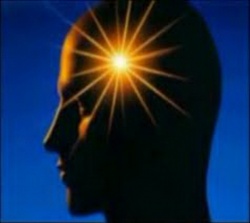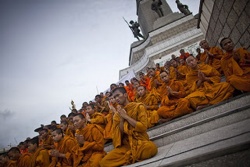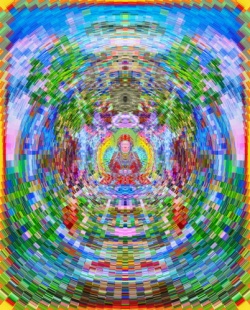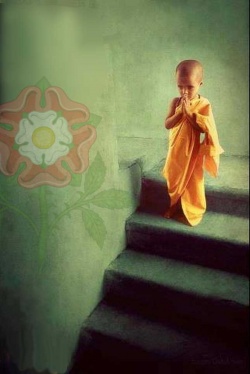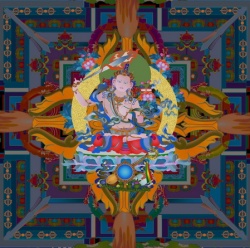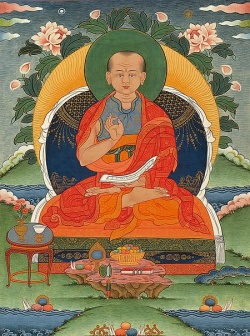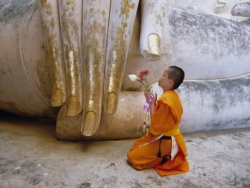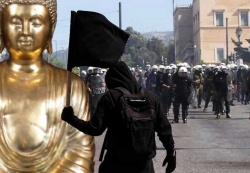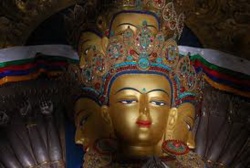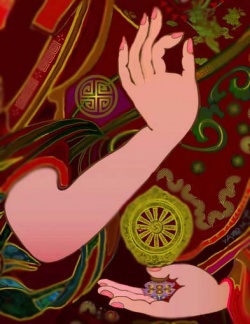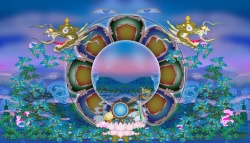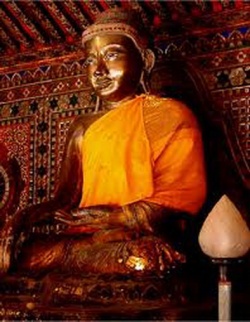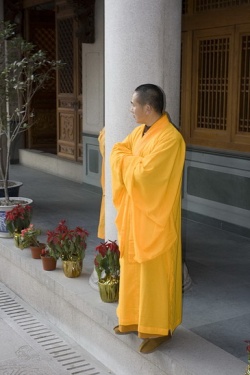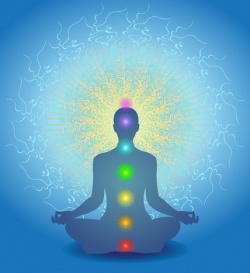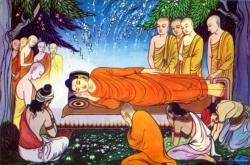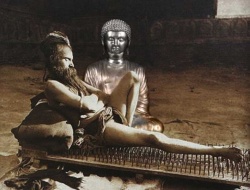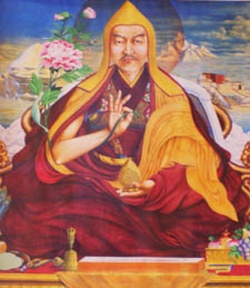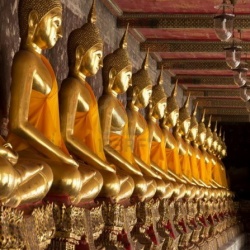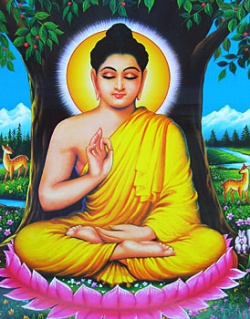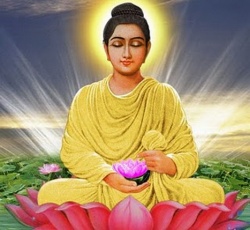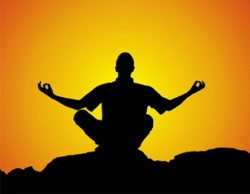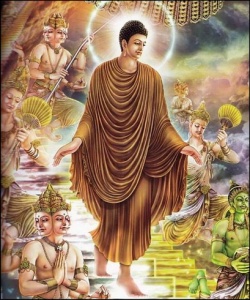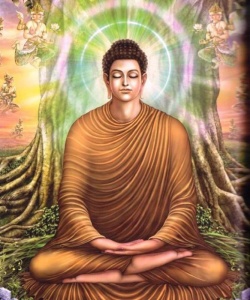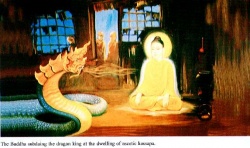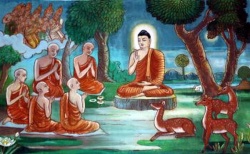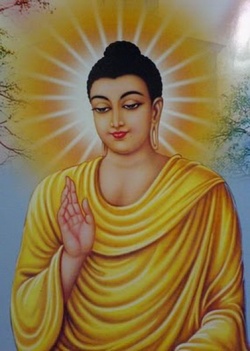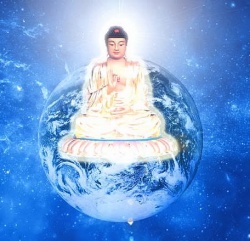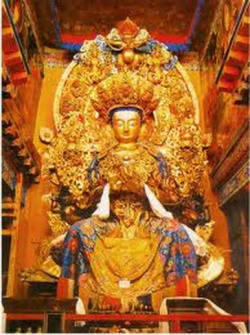Manual of Prajna Paramita - CLASS NOTES
Class One: Perfection of Wisdom; the Three Jewels
[Everything in this course is from the Svatantrika school)
Shakyamuni Buddha taught it for 51 years; three books remain:
GYE DRING DU SUM
long middle short three
The long sutra on Prajna Paramita Sutra has 100,000 verses
The middle sutra has 20,000 verses
The short has 8,000 verses
Together they are called YUM, or mother, because the perfection of wisdom produces all the Buddhas.
These books only remain in Tibetan. The Sanskrit libraries were burned by Moslems invading India.
The commentary was taught by Maitreya to Asanga (~350 A.D.). The commentary on the three books above by Asanga/Maitreya is called Ornament of Realizations (short GYEN in Tibetan). It’s 50 pages in a code, so we need a commentary on this commentary. That commentary is by Haribhadra (850 A.D.), called Clarification. That one is too hard also, as is
Je Tsongkhapa’s commentary (~1400). So we study the commentary by Kedrup Tempa Dargye (1493-1568), called the Analysis of the Perfection of Wisdom.
Definition of Prajñaparamita: - The perception of emptiness under the influence of the desire to help all sentient beings. - emptiness with love (bodhichitta).
Realization or understanding of emptiness (wisdom) without bodhichitta isn’t perfected. Bodhichitta without understanding emptiness isn’t perfected.
Arya is anyone who has direct perception of emptiness.
Arhant is anyone who has reached nirvana. After you perceive emptiness directly, it requires training and the application of that direct perception of emptiness to your thoughts to change the way you think and behave to reach nirvana and become an Arhant.
There are three levels of Perfection of Wisdom:
1.) Perfection of Wisdom of the path - one who has seen emptiness directly and has bodhichitta. This person is not yet a Buddha.
2.) Perfection of Wisdom of the result - One who has seen emptiness directly and sees all things simultaneously as both empty and deceptive reality. Sees all past, present, and future simultaneously. This person is a Buddha.
3.) Books about Perfection of Wisdom and teachings. (The sounds of the words of the Buddha.)
Refuge – Buddha, Dharma, Sangha – Three Jewels
For refuge to be real, there must be:
(1) fear of suffering, i.e. wanting protection (renunciation), and
(2) belief that something can help/protect you. Nothing in the world can protect you from suffering, except for the Three Jewels. (Called jewels because we go to them for refuge.)
The Buddha Jewel is the ultimate protection. The Buddha has reached the end of the path and has satisfied both needs (his own and others’).
The Dharma Jewel is the teachings. The Buddha is no good to you if he or she can’t communicate with you. The teachings are in:
1) books/words
2) in the hearts of people who have the paths/ideas in their mindstreams. The Dharma jewel is two parts: path: (idea) which leads you out of suffering, and cessation: which is stopping bad qualities within you.
The Sangha Jewel is anyone who has perceived emptiness directly.
Ultimate Refuge - any refuge where the process of the journey along the path has reach its final goal, i.e. a Buddha or something about a Buddha.
Class Two: Refuge – Five Divisions/ Eight Qualities of a Buddha
Definition of going for Refuge:
YUL SHEN-LA RANG-TOB-KYI REWA CHAWAY SEMPA
object another to itself power by hope all movement of the mind
KHAMDREY TSENYI
Refuge is that thought which of its own power puts all its hopes in another (external) object. Going for refuge is different from the object of refuge. You go for refuge to the object of refuge.
Two kinds of refuge:
1.) ordinary - People in the world take refuge in worldly or material things (food, sex, $).
2.) exceptional - Buddhist refuge in the Three Jewels. When you have refuge, you have the state of mind of being fearful, and go for protection with the absolute certainty that it will help.
Five divisions of Buddhist (exceptional) refuge:
Three types of practitioner:
KYEBU CHUNG DRING CHENPO SUM
person small middle big/great three
1.) Small: Small scope is the minimum motivation you can have and still be Buddhist. Wanting to escape the three lower rebirths. If you work with this motivation, you will get all things you need in this life also, because the virtues necessary to avoid lower rebirth are the same ones that bring happiness now.
2.) Medium: Motivation is to escape all forms of suffering cyclic existance. Understand that all is suffering and every satisfaction is transient.
3.) Great: Motivation to escape all forms of suffering for self and all others. (Must also have lower and medium motivations)
GYUI KYAMDRO DREBUI KHAMDRO cause going for refuge result going for refuge
4.) Result refuge: Going for refuge in my own future Sanghahood, Dharmahood, Buddhahood.
5.) Cause refuge: Going for refuge in some quality which has already been achieved in another person, going for refuge to another person who has the Three Jewels already established in their mind.
Why take refuge - In the short term (this life) there is no better protection. In the long term, you can achieve Buddhahood (because you must have refuge to practice tantra, which leads to Buddhahood.)
Eight qualities of a Buddha (from Uttaratantra by Maitreya/Asanga)
1.) Uncaused - his Dharmakaya is uncaused; the emptiness of his omniscience is uncaused; his emptiness is uncaused.
2.) Spontaneous - the Buddha will spontaneously appear to any being as soon as they are ready or ripe; similar to the moon always being ready to appear in any water that exists.
3.) Realized by no other way - one can’t perceive the Dharmakaya conceptually or with sense perception.
4.) Knowledge - aware of our condition of suffering.
5.) Love - cares about all.
6.) Power - to do something based upon love and knowledge of our condition. His power is to teach you.
7.) and 8.) Fulfills both needs – mine and his. He has no suffering. He is totally available to fulfill our needs; we aren’t able to take advantage because of our Karmic disposition.
Class Three: Bodhicitta and Mind
Short Definition of Bodhichitta:
SEMKYE PA NI SHEN DUN DU YANGDAY DZOKPAY JANGCHUB DU
Bodhichitta is for the sake of others total Enlightemnent the wish
Bodhichitta is defined as the wish to achieve total enlightenment for the sake of others.
The Svatantrika (lower Madhyamika) school says there are three Buddhahoods, i.e. three tracks, each with a different goal:
Mahayana——————(has five paths)——————> Buddhahood
Self-made Buddhas——-(has five paths)——————> Nirvana
Listeners (Shravakas)—-(has five paths)——————> Nirvana (called “listeners” because
they can hear and teach Mahayana, but don’t practice it.)
Each type of Buddhahood has five paths: accumulation, preparation, seeing, meditation, and no more learning. Each set of paths has different realizations while on those paths; each track perceives a different type of emptiness. Both nirvanas and Buddhahood have eliminated all suffering, but only Buddhahood has omniscience of all things.
There are three different semkyes, or wishes for enlightenment: mahayana semkye is to benefit all sentient beings. The other two are for the two nirvanas above – listeners and selfmade Buddhas.
Long definition of Bodhichitta:
First, it is the main mental awareness belonging to the greater way, which is focussed on achieving total enlightenment for the benefit of others, and which is matched with a state of mind that is associated with it: the aspiration to achieve total enlightenment. Secondly, it is a knowledge belonging to the greater way, which acts as a door for entering the greater way (or is something of the type), and which is included into the activity side of the standard division into the two of “view” and “activity”.
Bodhichitta is the “main” mind: it holds the two thoughts of Bodhichitta – wanting to be a Buddha and wanting to help all sentient beings. Because the mind can’t hold two thoughts simultaneously, then Bodhichitta must be main mind; otherwise it would lose Bodhichitta when thinking of wanting to help all sentient beings.
The main mind can hold two complimentary thoughts simultaneously, but not two different thoughts. Main mind is awareness of an object – holding the object in the mind. Secondary mind is feeling good, bad, etc. about that object. Main mind focuses on the object and secondary mind follows after that.
The definition of bodhichitta uses “mental awareness” to qualify that this doesn’t refer to the sensory consciousness or awareness of the Buddha.
It uses “belonging to the greater way” to signify that pre-bodhichitta (artificial or “sugar-cane” bodhichitta) – that bodhichitta which we try to force upon ourselves or try to get – isn’t what is meant. Rather, it means the feeling just comes without effort. That is the real and genuine bodhichitta, and the entry into Mahayana.
The use of “for the benefit of others” in the definition of Bodhichitta clarifies that it doesn’t mean the enlightenment of listeners or solitary realizers.
It uses “total enlightenment” to qualify that it’s the wish for the enlightenment of Buddhahood rather than of nirvana.
Class Four: Classifications of Bodhicitta
The Five Paths to Buddhahood:
(The names don’t necessarily describe each path accurately.)
Accumulation: To get on the first path, one must generate renuciation (and bodhichitta for Mahayana). This primarily refers to renunciation, and not to the accumulation of merit, although we do accumulate merit with renunciation.
Preparation: Preparing to see emptiness directly. The intellectual understanding of emptiness.
Seeing: Direct perception of emptiness (only takes a few minutes). The first bodhisattva bhumi is gained when you see emptiness with compassion in your heart.
Habituation: Getting used to and practicing what you saw in emptiness and reorienting your perception of what you see around you daily to agree with the perception of emptiness. Getting rid of inborn habit of seeing things as self-existant. (This takes a long time to practice.)
No more learning: Nirvana or Buddhahood attained. Got rid of all bad thoughts permanently.
Classifying bodhichitta by level of spiritual understanding (four types)
1. MUPA CHUPAY SEMKYE
belief act wish for enlightenment
Person acting out of belief that things aren’t self-existant - has enlightened wish to help all sentient beings, and hasn’t seen emptiness. Want to help sentient beings and wants to become Buddha to do so. Realizes that they see things as deceptive reality and has belief that emptiness exists. Thinks things are self-existant, sees things as self-existant, and believes that things are not self-existant. (This kind of bodhichitta occurs on paths of accumulation and preparation.)
2. HLAKSAM DAKPAY SEMKYE
takes absolute pure wish for enlightenment personal responsibility
Someone who has experienced emptiness directly and sees things as they really are, so that bodhichitta is more intelligent and stronger. Has given up intellectual belief in self-existance as a result of seeing emptiness. Knows things are not self-existant, but is forced to see them that way outside of emptiness meditation. Has inate belief/view of self-existance. Sees things as empty in meditation and self-existant out of meditation. Person who permanently no longer has any belief in self-existance because of having seen emptiness directly. Doesn’t believe in self-existance, but still sees things as deceptive reality and has the seeds to see things as deceptive. (Occurs on paths of seeing and habituation.)
3. NAMPAR MINPAY SEMKYE
ripening bodhichitta
Someone who looks at sentient beings and wants to help. When looking at sentient beings, doesn’t see them as self-existant, but still has seeds to see them as self-existant. Has given up inate belief of self-existance; no longer sees self as self-existent. Outside of meditation, sees everything as empty. Has given up the inborn habit of seeing things as self-existant. Can never again see things as self-existant, although still has the seeds to see things that way. Not a Buddha yet, because there are still karmic seeds in the mind to see things as self-existant.
Doesn’t think things are self-existant, doesn’t see things as self-existant, but has the seeds to see things as self-existant. (The path of habituation has this kind of bodhichitta. Bhumis eight through ten occur here.)
4. DRIPPA PAKPAY SEMKYE
obscurations eliminated bochichitta
This person doesn’t think things are self-existant and doesn’t see them as self-existant.
There are no more seeds to see self-existance. This is a Buddha.
Dividing bodhichitta by the way one thinks (three types):
1. GYALPO TABUI SEMKYE
king – like bodhichitta
“I’ll get enlightenment first and then lead others to enlightenment.”
2. DZIBU TABUI SEMKYE
shepherd – like bodhichitta
“I’ll make sure others achieve enlightenment and then I’ll do it.”
3. NYENPA TABUI SEMKYE
ferryman – like bodhichitta
“I want to reach enlightemnent at the same time as all sentient beings. We’ll go together.”
Dividing Bodhichitta by its basic nature (two types):
1. MUNPA SEMKYE
The wish for enlightenment that does not directly depend on taking the bodhisattva vow and engaging in bodhisattva deeds.
2. JUKPA SEMKYE
engaging bodhichitta
The wish for enlightenment that directly depends on taking the vow and actually engaging in the bodhisattva deeds. (When you take a vow to do or not to do something, then the action is much more powerful; breaking the vow is much more detrimental.)
Apparent bodhichitta - Wanting to become a Buddha to help all sentient beings.
Ultimate bodhichitta - Direct perception of emptiness. (Nothing directly to do with helping others.)
Class Five: Definitions of Nirvana
What is Nirvana?
NYUN-DRIP MA-LU-PA PANG PAY SO SOR TAK-GOG NYANG-DE
klesha obstacle in their eliminated one-by-one see cessation nirvana
mental affliction entirety
Nyun-drip means the mental afflictions (bad thoughts) and bak-chaks (potentials for bad thoughts, seeds, mental stains and predispositions to behave similarly again) that block or stop you from nirvana. A seed is a potential (to get angry, for instance) which will be triggered by events in the future.
Nyang-de, or nirvana, is an abbreviation for nyang-ngen (grief) le (beyond) depa (gone), or gone beyond grief.
Definition of nirvana:
Nirvana is a cessation which comes from the individual analysis, and which consists of having eliminated the mental-affliction obstacles (and bak-chaks) in their entirety from your mental stream. Here, individual analysis refers to realizing the Four Arya Truths one-by-one after seeing emptiness directly.
Cessations can be divided into two types: those you get before seeing emptiness (you have these on the first two paths) and those you get from seeing emptiness directly (on the third path – the path of seeing).
The Four Noble Truths should be translated as the Four Arya Truths, because you see each of the four truths after becoming an arya (seeing emptiness), as you come down from the direct perception of emptiness. You see that life is suffering, and the cause (your own bad thoughts),cessation (and you see how many lives you have until you are finished), and the cause of cessation (the path).
A bak-chak is an energetic potential or seed which arises when conditions are right. Once you see emptiness directly, you stop creating new causes for suffering, but you still have past seeds to experience. The process of death practice largely involves going through death without activating our bak-chaks. They’re there, but by not watering or activating them, they can’t cause our lower rebirth.
A mental affliction is mental – made of mind.
Class Six: Divisions of Nirvana
Four Types of Nirvana: (there are more, but we’re doing only four)
1.) RANG-SHIN NYANG-DE
natural nirvana
Natural nirvana. This is ultimate reality. It’s been like this forever, it occurs naturally. (This is a misnomer, because it’s not a real nirvana. It’s grouped with nirvana because it can never cause mental afflictions.) (continued in class six)
2.) HLAK – CHE NYANG-DE
something having nirvana
left-over posessing
Nirvana with something left over: you attain nirvana and still have your body left over to finish this life, as well as karmic seeds.
3.) HLAK – ME NYANG-DE
nothing left over nirvana
Nirvana with nothing left over: you attain nirvana and don’t have a body after you die. Still have some karmic seeds.
4.) MI-NE-PAY NYANG-DE SI – TA SHI – TA
not to stay nirvana samsara edge/extreme peace edge/extreme
Nirvana which does not stay in the extreme of samsara or in the extreme of peace (i.e. lower nirvana). Means the nirvana of a Buddha. Some lower schools say that when you reach nirvana with nothing left over, there is no longer a body or mind to the person; there is a person existing some way in cessation.
Five Heaps or Piles: (skandas)
2) Feeling (mental function of feeling) – sensory and emotional – You are always feeling. Can be divided into pain, pleasure, or neutral.
3) Discrimination - ability to distinguish between two things. (It’s a mental function)
4) Other Factors - everything not included in the other four heaps.
5) Main mind-consciousness - Six types: mental awareness, eye, ear, nose, taste, and touch awareness.
Out of the 46 mental functions feeling and discrimination are separate, because they are the source of samsara. You discriminate between two things, and say, “I like this and don’t like that.”
Things needed to get to Nirvana - all must be present:
1.) DAK – ME TOK-PAY SHE-RAB KYI LAP-PA
self-nature no realization wisdom of training
Training in the wisdom realizing emptiness. The training of wisdom that realizes that nothing has any nature of its own (i.e. wisdom realizing emptiness).
2.) LAP-PA DAN-PO NYI-KYI SIN-PA
training first two of under influence
Doing so under the influence of finely-tuned morality and concentration (the first two trainings)
3.) TOK – SIN GOM – PA
realization already habituate, or get used to
Getting used to what you’ve already realized about emptiness by habituating the mind.
Four results of the Buddhist path:
1.) Stream-enterer - first step of being on your way out of samsara. Seeing emptiness directly, and becoming an arya.
2.) Once-returner - Will take rebirth in the desire realms one more time.
3.) Non-returner - Will not come back to the six desire realms again.
4.) Arhant - “foe-destroyer” has attained nirvana by destroying the bad thoughts and their seeds.
Class Seven: Proof of Emptiness; Understanding the Gak-ja
Identifying the object that we deny:
GAK – JA
to deny or refute object to be
Gak-ja means self-existant thing, a thing which exists by itself. There is no such thing. It is self-nature. The thing or object which we deny exists; the thing which emptiness is empty of.
When we speak of emptiness, emptiness means something is missing or isn’t there. The gak-ja is what isn’t there in emptiness.
If you don’t know what emptiness is empty of, you can’t study emptiness. If you don’t understand what exists, you can’t refute its existance (ex. if you don’t know what a vase is, you can’t prove there isn’t one on the table.) You must have good understanding of what a self-existant thing is.
The gak-ja does not really exist. If it did exist, it would have to exist in a way opposite to the way in which things really do exist (conventionally or deceptively). You can’t have a negative emotion unless you are focused on a gak-ja - a thing which doesn’t even exist.
LO NU – ME LA NANG-WAY WANG – GI SHAK – TSAM
mind hurt not to appears power by the established just
(i.e. mind unimpaired by as existing illness, anger, drugs, etc.)
Svatantrika position of how things exist (in conventional reality or dependant origination): Things exist in dependence on
1.) the thing being out there (ex. flowers), and
2.) someone perceiving them with an unimpaired mind. Both factors must be present. It does not exist out there through some way of being on its own.
The gak-ja is anything which appears without one of the two factors above being present. If something existed out there on its own without depending on me perceiving it or it appearing to me, that’s a gak-ja.
The way in which things exist conventionally is that the flowers appear to me and I see them.
They don’t exist out there on their own as a self-existant thing. We normally see things as a gak-ja, independent of factors, and out there self-existantly.
Example: The Magic Show
The magician in a crowd takes a stick, casts a spell, and turns it into a horse. The crowd sees a horse. The magician sees a horse, but believes it’s a stick. The spell requires a stick and a perceiver.
If there were no stick, then everything you look at would appear as a horse. The first component is important – something out there must appear as a stick or a horse (must have some stickness or horseness), or everything I see would appear as a stick or horse. If there were no spell, the crowd wouldn’t see the horse; they need the state of mind to see the horse.
Someone who comes up to the crowd after the spell just sees a stick there.
1.) Spectators - see a horse and believe there’s a horse there.
2.) Magician - sees a horse and doesn’t believe there’s a horse there.
3.) Latecomer - doesn’t see a horse and doesn’t believe there’s a horse there.
Corresponds to:
1.) Someone who has not seen emptiness directly sees things as self-existant and believes they are self-existant.
2.) Someone who has seen emptiness directly and who is not in meditation sees things as self-existant and but doesn’t believe it.
3.) Someone (not a Buddha) abiding in direct perception of emptiness doesn’t see things as self-existant and doesn’t believe they are self-existant.
Class Eight: Five Different Proofs of Emptiness
Five ways to prove emptiness: (elaborations for each follow in the next section.)
1.) CHIK – DU DREL
one many empty
The emptiness of one or many; do they exist as one or many?
2.) DORJE SEKMA
diamond sliver
Sliver of diamond: Things can’t arise from themselves, or from something else, or from both, or without a cause (i.e. neither from themselves nor from something else).
3.) YU – ME KYE – GOK
exist not to arise to deny
Denial that things which exist or do not exist could arise. Denying that a thing could grow (arise) from a thing that exists, or from something that does not exist, or from both, or from neither.
4.) MU – SHI KYE – GOK
possibilities four to arise to deny
The denial that things could arise through any of the four possibilities. Denying that multiple results come from multiple causes, denying that single results come from multiple causes, denying that multiple results come from single causes, denying that single results come from single causes.
5.) TEN – DREL GYI – RIKPA (also called RIK-PAY GYALPO)
interdependence of reasoning ( of reasons king )
Reasoning of interdependence (dependant origination) (also known as King of Reasonings).
Things are not self-existant because they depend upon other things.
How to prove a logical statement:
There are three (sometimes four) parts to every logical statement. The first part is the subject.
Example of the first argument, the emptiness of one or many:
1.) The first proof of emptiness (the emptiness of one or many) takes as its subject these three knowledges:
Consider the three knowledges:
a.) Basic knowledge - perception of selflessness.
b.) Path knowledge - perception of emptiness by a bodhisattva.
c.) Knowledge of all things.
2.) The second part of a logical statement is the characteristic we are asserting – what we are trying to prove – or the thing the other person doesn’t see:
They do not exist really. (Really refers to being self-existant, independent of my perception, and their appearing–i.e. as a gak-ja–from their own side.)
3.) The third part of a logical statement is the reason:
Because they do not exist really as one, they do not exist really as many.
4.) The fourth part of a logical statement is a supporting example (preferably something the other person has seen).
They are, for example, like a reflection of an image in a mirror. The image looks real, but isn’t.
Class Nine: First Proof of Emptiness – One or Many
Elaboration on how to prove a logical statement
Logical statements:
2.) The sun is not blue characteristic to be proven
3.) Because it is yellow reason
Proof of one or many:
If you prove that something doesn’t exist as one or as many, then you’ve proved it doesn’t exist at all, because there are no other options except not existing. One and many encompass all possible things.
Three relationships have to be there for a proof to be valid:
1.) The reason has to be a quality of the subject, i.e. the reason must be true about the subject. Here, 3 does connect to 1; the sun must be yellow, or you can’t apply the proof.
2.) The relationship between the reason and the characteristic it proves must be sound. Therefore, here it must be true that if 3 is true, then 2 occurs, i.e. if something is yellow, then it cannot simultaneously be blue.
3.) The relationship between the characteristic to be proven and its reason must be such that if you negate the characteristic to be proven and you negate the reason, their relationship is still true. Therefore, if you negate 2, 3 is also negated, as shown by the example: if the sun is not not blue (i.e. is blue), then it is not yellow. The person you’re proving it to must see and accept that the sun is yellow. He or she must accept that it can’t be yellow and blue sumultaneously, and that if it’s blue, it can’t be yellow.
All of these elements must already be present in their mind. The proof ties them all together, and points to the correct conclusion. Before, he had seen the sun, known what yellow is, and known that if something is yellow, it can’t be blue. He had thought the sun was blue because he had never tied the elements together before.
Statement of the first proof of emptiness – one or many
1.) Consider the three knowledges (see last week’s notes). They do not exist really because they don’t really exist as one or many. If you leave out “really”, then they do exist (as many). “Really” qualifies them, meaning that they exist dependent upon someone’s perception.
2.) The three knowledges do not exist really.
3.) For they do not exist really as one or really as many. If you can prove that a thing can not exist as one, then it can not exist as many, either. Here, many means a collection of the one(s), not many different things, but many of the one. For example, if you can prove that a Martian does not exist, then you don’t need to prove that 100 Martians don’t exist. We will prove that something (in this instance the three knowledges) doesn’t exist as one, really.
Proof of the first proof – things don’t exist really as one.
1.) Consider the three knowledges. (subject)
2.) They don’t really exist as one. (characteristic to be proven)
3.) This is because they have parts (according to the Svatantrika definition of emptiness.) (reason)
The three relationships must hold true:
a) 3 connects to 1 accurately.
b) If 3 is true, then 2 is true,
c) If 2 is negated, then 3 is negated.
How to prove that if they have parts they do not really exist as one (if 3, then 2):
Example: a pen – When you look at a pen, you cannot see the pen. You see the parts of the pen, for example the top, bottom, etc. It’s impossible to see the pen without looking at the parts of the pen. While you’re looking at the parts of the pen, it’s impossible to see the pen. You are seeing the top and then the bottom, then the back, etc. not the pen. You see various parts and clues, and then paint a complete picture in your mind of a pen for the thing which is out there, and believe it’s out there as a “pen”, rather than as a mental construct. If you perceive the parts, you can’t perceive the whole (one). If you weren’t perceiving the parts, you couldn’t see the object as existing at all.
Even when you focus on one part, you can’t see it. When you look at the top, it has parts too – the top of it, the bottom of it, etc. Ad infinitum, as above. So where does anything come from; how do we perceive it if we can’t even see one complete part of it? Your mind fills in the image in a certain way caused by your past mental karma/seeds/mental functions. For this reason, even though I want my mind to fill everything in as pleasure, it doesn’t. For example, I want to perceive every meal as tasty, but that doesn’t happen.
How to prove that the three knowledges have parts (that 3 is true of 1)
Take the approach that if we prove that everything has parts, this will also apply to the three knowledges. All things can be classified as changing and unchanging. Changing things are classified as either physical or mental. Physical things can be classified as gross or subtle.
All things
/ \
changing unchanging
/ \
gross subtle
To prove that all things have parts, we must prove that each subdivision
Gross physical things:
1.) If you cover part of a physical thing, another part is still there, so there must be parts. Covering two fingers leaves three fingers, so fingers are parts. Otherwise when you cover two fingers, none would be left.
2.) If you didn’t have parts, when you moved one arm then the other would move, if it weren’t a separate part.
Consider an atom. Do atoms touch, combine, or blend into each other, or do they occupy each other’s space so that every part of one atom is touched by the atom next to it? (O vs. OO) If they touch each other then there must be sides to it, which means it has parts (top, left, etc.).
If they existed in a way where every surface and point of an atom touched every surface and point of all others, then there would only be one atom in existance, and we wouldn’t have discrete objects like food, etc.
Mental things: (includes mind and mental functions, i.e. basic awareness and all the functions like anger, concentration, love, etc.)
Mental things have direct and remote causes:
Direct means happening right after the event, ex. Nina’s visual awareness of him. The direct cause is her visual awareness of him the moment before. Her eye, his skin, etc. are contributing factors, not a direct cause. Her perceiving him is the direct result. The direct cause flip-flops into the direct result without any time lapse. Like snapping fingers twice fast, with no space in between.
Remote means happening a moment or more after an event, with some pause between the events. For example, snap the fingers and pause before snapping a second time. The first snap is a remote cause of perceiving the second snap because you perceived the pause in between. Because mental things stream so that there are direct and remote causes for them (based upon time elapsed), they have parts. One mental event is composed of direct and remote causes – these are its parts, and to have them time must have elapsed. If there weren’t parts, then every prior mental event which leads to the next one would have to occur simultaneously and there would be one moment in time where everything occurred.
Unchanging things:
There are three main types: cessations, empty space, and emptiness.
Cessations include mental afflictions and their seeds. As an absence of something, their nature is unchanging. You don’t get more or less free of afflictions, you’re just free, so it’s unchanging in that its nature is constant. The parts are: cessation of intellectual belief in selfexistance, and cessation of inate or inborn belief in self-existence.
Empty space is defined as the absence of an obstruction. Its parts are north, south, east, etc.
Emptiness never changes; it can go in and out of existence; it has no beginning or end. Each object has its own emptiness, and all objects’ emptinesses are the parts of emptiness.
If everything in the universe has parts, then nothing exists really, which we have just proved.
Class Ten: Who is Maitreya?
In Tibetan: JAM-PA
In the open teachings, he is considered a bodhisattva; in the secret teachings he is considered a Buddha.
The teacher is the only connection to the Buddha. Without the teacher, you can’t learn the wisdom of enlightenment. He is the only window to the information, so you should treat him well. Even if he isn’t a Buddha, you should treat him as one anyway, because of this. As a Buddha, Maitreya still has the desire to fulfill his own needs.
b) The person who practices the tantra must be someone who is leading a very pure life.
See also
- Manual of Prajna Paramita - Reading One: The Three Kinds of Refuge
- Manual of Prajna Paramita - Reading Two: The Wish for Enlightenment
- Manual of Prajna Paramita - Reading Three: What is Nirvana?
- Manual of Prajna Paramita - Reading Four: The Object We Deny
- Manual of Prajna Paramita - Reading Five: The Proofs for Emptiness
- Manual of Prajna Paramita - Reading Six: Who is Maitreya?
- Manual of Prajna Paramita - CLASS NOTES
